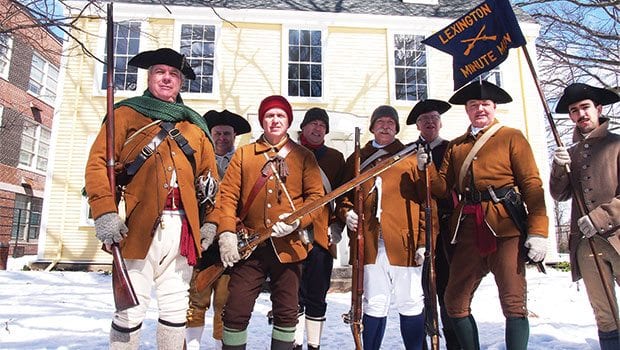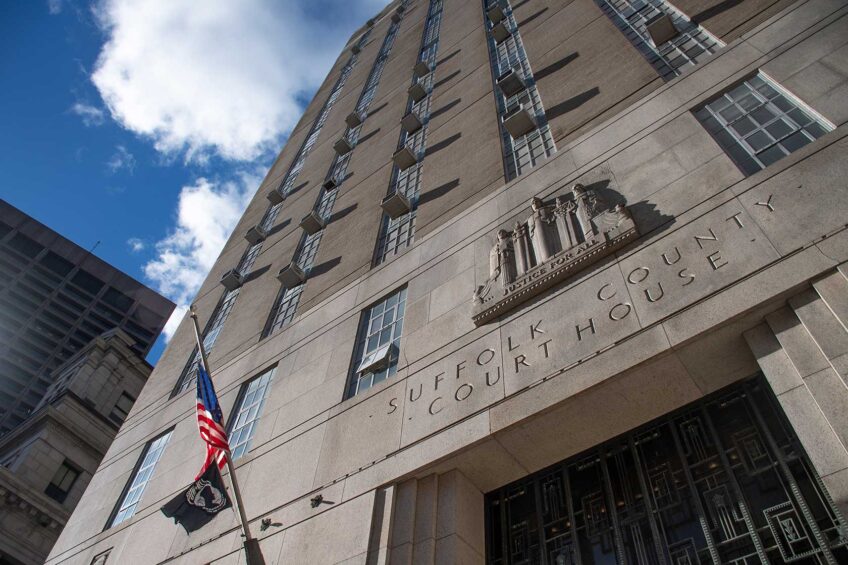Marking Roxbury’s revolutionary history
Roxbury, South Boston historical groups commemorate expulsion of British troops

Back in December, 1775 when General Henry Knox sought to transport 60 tons of cannons from Fort Ticonderoga, New York over frozen Lake George and the snow-covered Berkshire Mountains to Boston, the 300-mile trip took three months.
In more recent history, the last leg of the trip — from the Roxbury headquarters of General George Washington’s Continental Army to Dorchester Heights, the highest point in present-day South Boston — has often seemed more distant. While markers commemorating Knox’s historical feat were laid throughout New York and Massachusetts in 1926, terminating at a Dorchester Heights monument to the Continental Army’s fortifications, it wasn’t until 2009 that Roxbury received a marker for the Knox Trail.

Knox Trail marker
During an Evacuation Day commemoration Saturday, members of the Lexington Minutemen re-enactors stood in front of the Eliot Square house where General John Thomas was stationed with a regiment of troops during the siege of Boston, and asked in which direction Dorchester Heights was. Turning east, the hill and the towering white marble Dorchester Heights Monument were visible straight down Roxbury Street, little more than two miles distant.
“Over the years there has developed a kind of psychological distance between the neighborhoods,” said state Rep. Byron Rushing, who has participated in recent Evacuation Day celebrations, held jointly by the Roxbury and South Boston historical societies. But from the hills where Washington’s troops erected their forts, that distance melts through the lens of historical perspective, according to Rushing.
“The sense you get is how close all of this was together,” he said.
South Boston Historical Society President Robert J. Allison says many have had the geographical epiphany Rushing describes in the 15 years the historical societies have been holding joint commemorations.
“There were people from South Boston who had never been to Fort Hill,” he said. “You can see how close we all are.”
Standing atop Dorchester Heights in South Boston — a feat Rushing and other black Bostonians might not have tried during the racial unrest of the 1960s ’70s and ’80s — one can also see why the Continental Army chose that site to mount the cannons Knox and his men transported from Ticonderoga. From Dorchester Heights, the battery the troops erected on the night of March 5 commanded the harbor, giving them the power to sink the ships that were the sole means the British had of supplying their troops during the siege of Boston.
British troops had been dug into the city, which then occupied a small peninsula connected to the mainland by narrow neck that extended to Roxbury. Washington’s troops set up redoubts near the Eustice Street Burying Ground, hemming the British troops in, while the British had their fortifications on the neck, which convinced Washington’s advisors that a land invasion of Boston was impossible.

Rep. Nick Collins at the Shirley Eustice House.
The siege of Boston, which began in April of 1775, ended when the British, convinced they were out maneuvered, left Boston on March 17, 1776 with a tacit agreement that in exchange for not destroying the city, they would be allowed to leave unharmed. With favorable winds, their fleet of 120 ships carried more than 9,000 soldiers, effectively ending Britain’s major military activities in the New England colonies.
Evacuation Day, which corresponds with Saint Patrick’s Day, was first established as an official holiday in Boston in 1901. The joint celebration between the Roxbury and South Boston Historical Societies is a more recent development.
Rushing, who went to high school in Syracuse, New York, grew up knowing the New York side of the story, wherein generals Benedict Arnold and Ethan Allen overran the Fort Ticonderoga and Crown Point camps, securing 60 tons of cannon, as well as other munitions. General Knox’s feat, hauling the cannons and munitions through New York and the Berkshires with teams of oxen and sledges, has been credited as one of the greatest feats of engineering during the Revolutionary War.
Between 1926 and 1927, New York and Massachusetts began laying 56 commemorative plaques to mark Knox’s journey. South Boston Historical Society President Robert Allison said the 2009 placement of a marker in Roxbury, a few hundred yards from the front lines of the siege, underscores the centrality of the community to the war.
“The cannons came past here,” Allison says, standing in front of the granite marker, which features a bronze bass relief depiction of Knox’s men leading the sledge-pulling oxen.
This year’s observance included commemorations at Dorchester Heights in South Boston, and in Roxbury at the Dillaway Thomas House and at the Shirley Eustis House, where lunch was served. In South Boston, students from local schools were given awards for posters they made commemorating Evacuation Day. The winners were given their awards in the wintery chill of Dorchester heights.
“It’s a great way to celebrate and bring the history alive,” South Boston state Rep. Nick Collins said of the commemoration. “It symbolizes not just what we can achieve when we work together, but also that we can rely on each other. We can reflect on how difficult things were back then as we face political and societal problems today.”
This year, to mark the 250 years since Red Coats arrived in Boston to maintain order (and colonial subjugation), re-enactors will establish encampments in Boston this summer. Allison says the South Historical Society has not yet settled on locations for the encampments.
“We’re thinking of the Shirley Eustice House and Castle Island,” he said. “We’re looking at how we can use this to get the history into the schools.”







